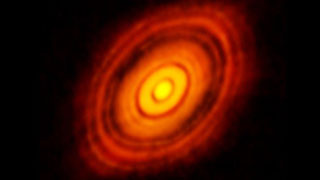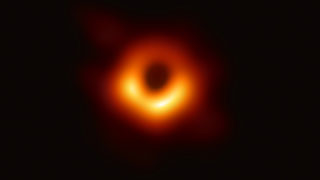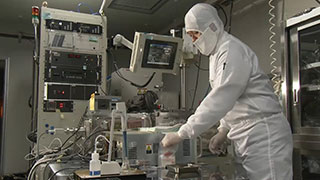ALMA Discoveries
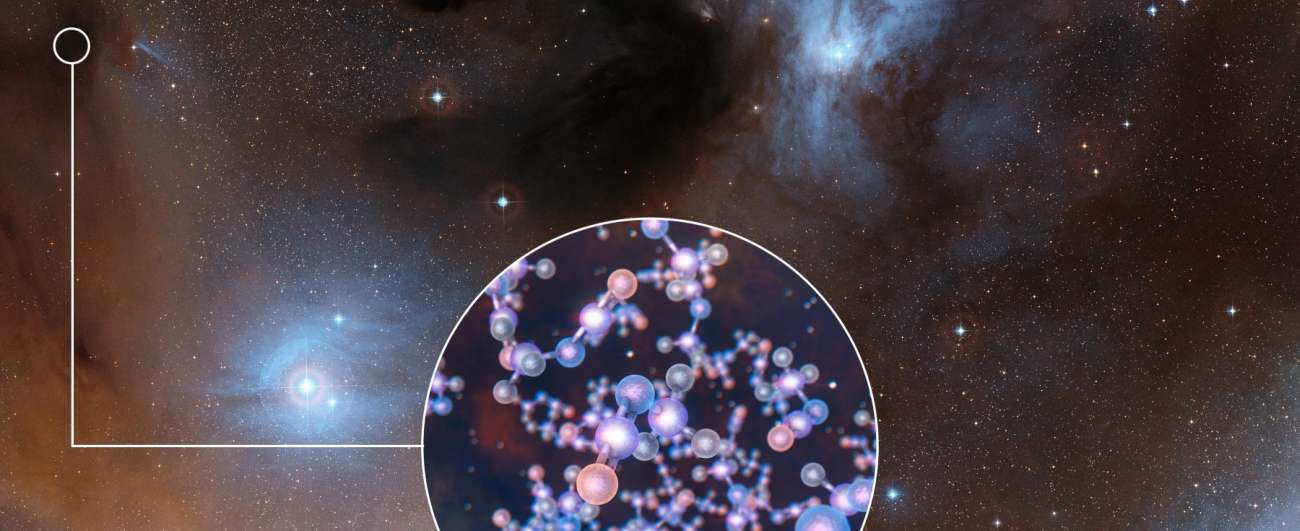 Credit: ESO/Digitized Sky Survey 2/L. Calçada
Credit: ESO/Digitized Sky Survey 2/L. Calçada
- TOP
- ALMA Discoveries
- Organic Molecules
Organic Molecules
Our bodies are made of protein. Proteins are made of amino acids. Are amino acids found in abundance in the Universe? Do amino acids float outside of our Solar System, in places where stars and planets are born? ALMA, with its exquisite sensitivity, can capture faint radio waves emitted at specific wavelengths by various organic molecules related to the origin of life. Detailed analysis of the cloud composition provides us with an important clue to tackle the ultimate question of humankind, "Is there life outside of Earth?"
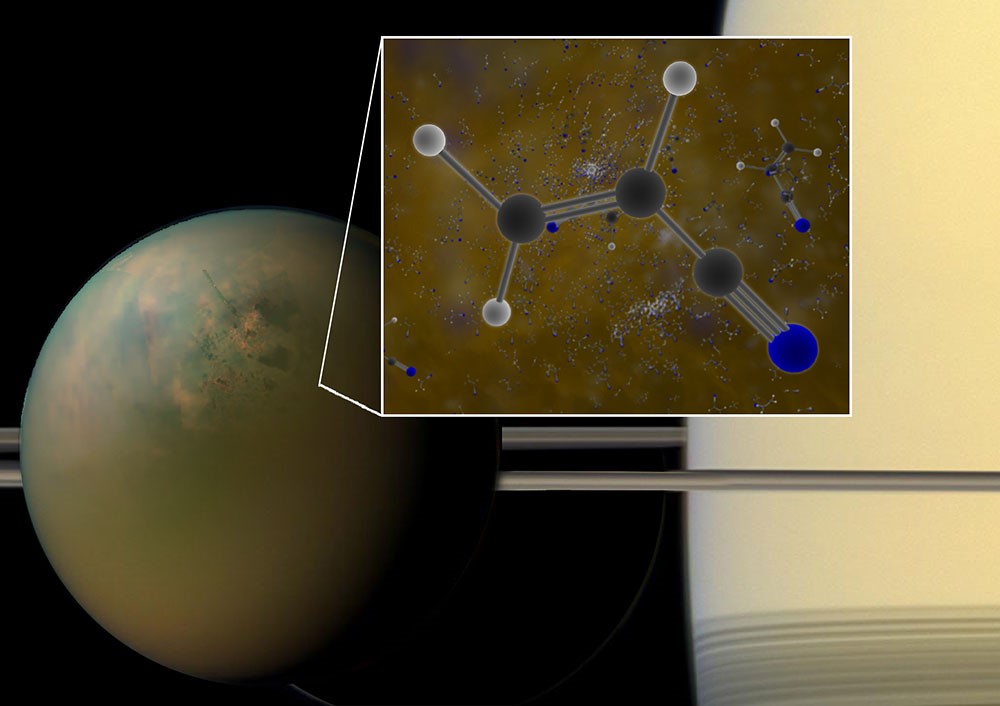 Credit: B. Saxton (NRAO/AUI/NSF); NASA
Credit: B. Saxton (NRAO/AUI/NSF); NASA
Organic World on Titan
Titan, Saturn's largest moon, has an atmosphere composed mainly of nitrogen, and the environment may be similar to the ancient Earth. ALMA has discovered an organic molecule called acrylonitrile in Titan's atmosphere. In an environment rich in methane, such as Titan's, acrylonitrile molecules may be neatly aligned to form a membrane-like structure. Membranes, which separate the outside world from the inside of the body, are essential structures for life. Studying Titan‘s atmosphere will thus lead to the understanding of the chemical reactions that occurred in ancient Earth, before the birth of life.
News article: "ALMA Confirms Complex Chemistry in Titan’s Atmosphere: Saturn’s Moon Offers Glimpse of Earth’s Primordial Past"
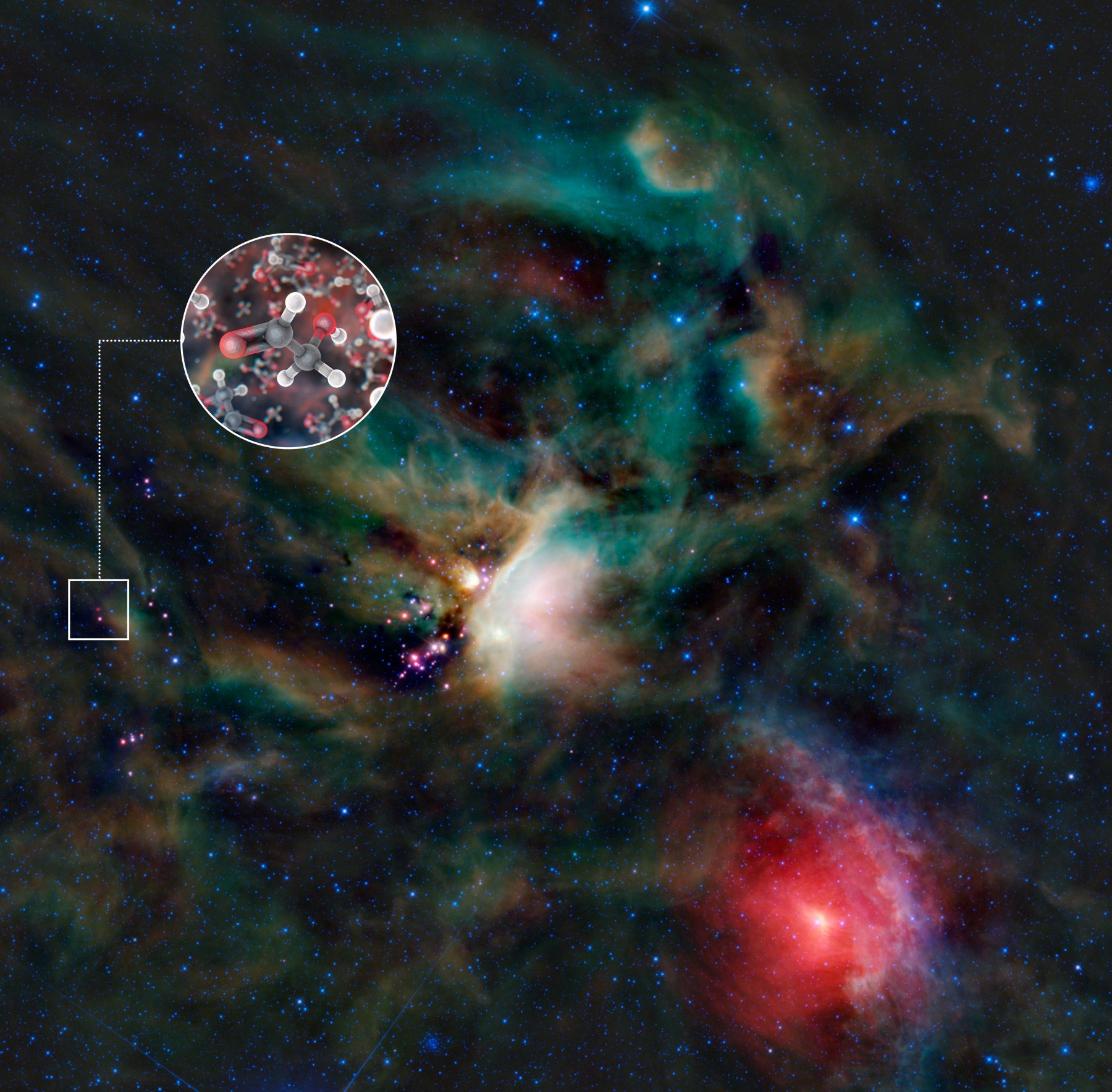 Credit: ESO/L. Calçada & NASA/JPL-Caltech/WISE Team
Credit: ESO/L. Calçada & NASA/JPL-Caltech/WISE Team
Sugar around Baby Star
The simplest sugar molecule, glycolaldehyde, was discovered around the baby star IRAS 16293-2422 based on the test observation data obtained before ALMA began its science observations. This sugar molecule was found at the location where the environment is adequate for future planet formation, suggesting a possibility that this sugar can be incorporated into the to-be-formed planet. This is the first discovery of a sugar molecule around a baby star. The fact that the discovery was made based on test data raised high expectations for the search for building blocks of life with ALMA.
News article: "Sweet Result from ALMA - Building blocks of life found around young star"
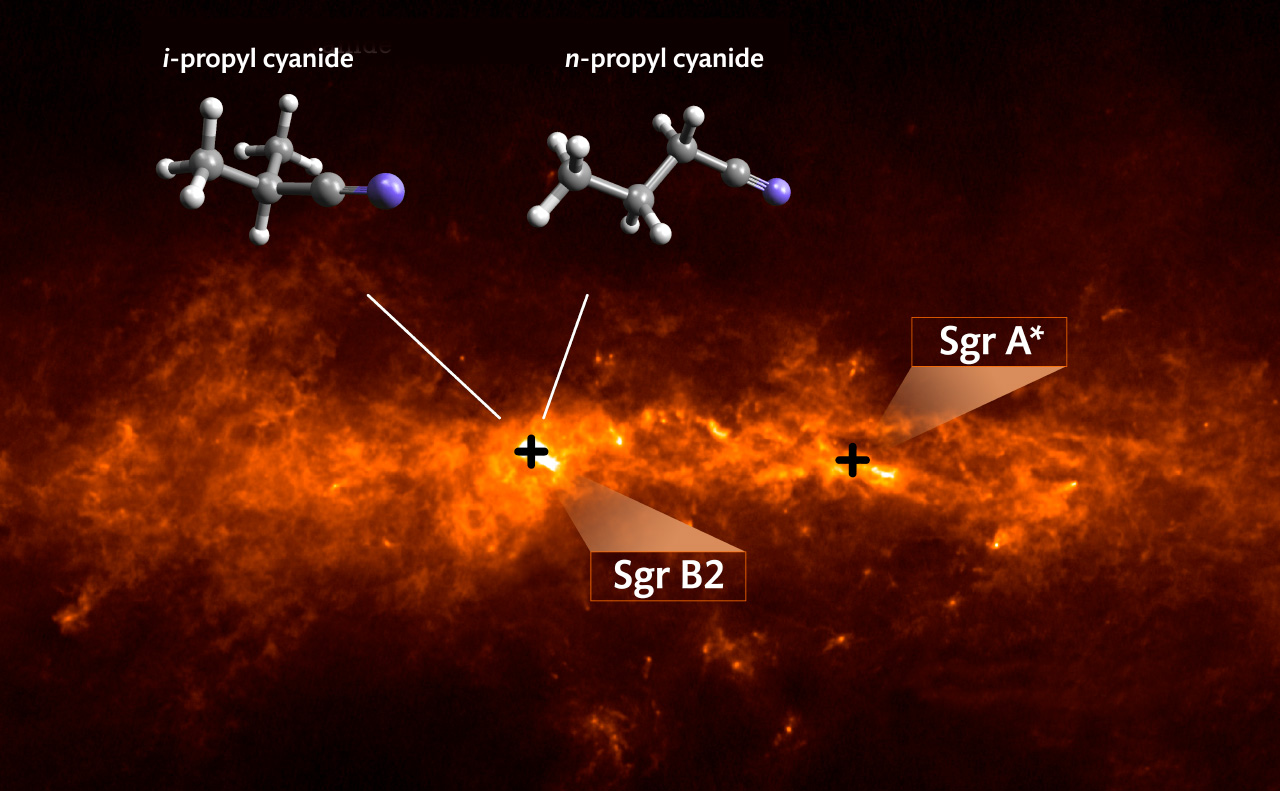 Credits: MPIfR/A. Weiß (background image), University of Cologne/M. Koerber (molecular models), MPIfR/A. Belloche (montage)
Credits: MPIfR/A. Weiß (background image), University of Cologne/M. Koerber (molecular models), MPIfR/A. Belloche (montage)
Branched Organic Molecules in Space
Amino acids are found in asteroids that have entered and survived the Earth’s atmosphere. Some of them contain a branched “backbone” structure: oxygen and hydrogen atoms connected to a chain of carbon atoms. ALMA has discovered organic molecules with such a branched structure in an active star-forming region in the Milky Way. The study showed that molecules with a branched carbon backbone structure are found in abundance in this region. This provided new evidence that amino acids, the basis of proteins, are also likely to be produced in space.
News article: "ALMA Finds that Organic Molecules are Branching Out"
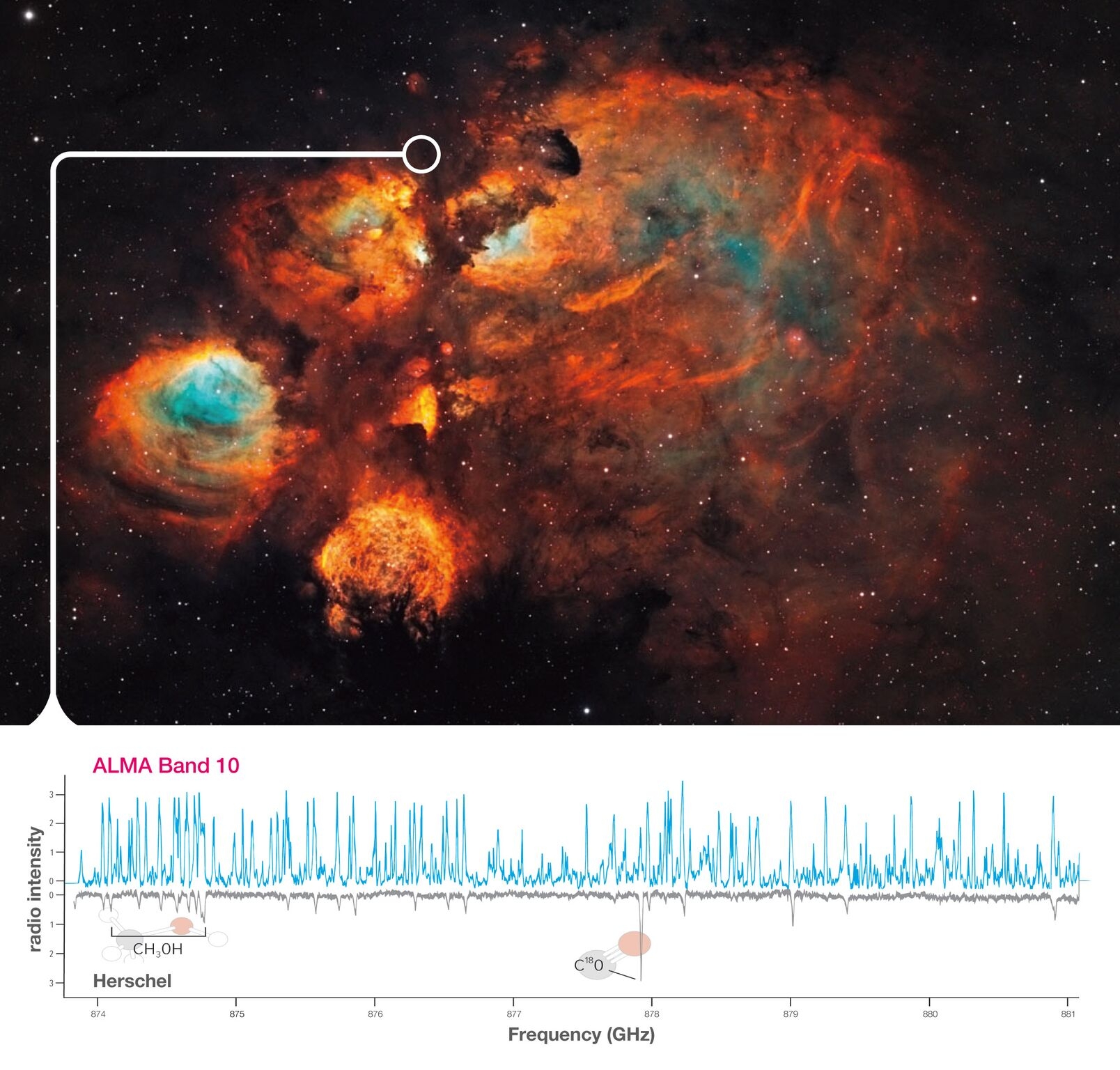 Credit: S. Lipinski/NASA & ESA, NAOJ, NRAO/AUI/NSF, B. McGuire et al.
Credit: S. Lipinski/NASA & ESA, NAOJ, NRAO/AUI/NSF, B. McGuire et al.
Molecular Line Forest Seen with Japanese Receiver
ALMA is equipped with radio receivers developed by the participating countries. The "Band 10" receiver, which observes the highest frequencies in the ALMA bands, was developed by Japan. The active star-forming region Cat's Paw Nebula (NGC 6334) was observed using the Band 10 receiver, discovering a wide variety of molecules that includes organic molecules. ALMA detected ten times more molecules than the same observation conducted by the Herschel Space Observatory, demonstrating the exquisite sensitivity offered by ALMA. The wealth of data allowed astronomers to address questions such as “what are the important chemical reactions in the star-forming region?” and “what molecules are being produced?”.
News article: "ALMA’s Highest Frequency Receiver produces its First Scientific Result on Massive Star Formation"
 Credit: ALMA (ESO/NAOJ/NRAO), Lee et al.
Credit: ALMA (ESO/NAOJ/NRAO), Lee et al.
Warm Reservoir of Organic Molecules
V883 Orionis is a variable young star that brightens rapidly from time to time. Observations of the gas disk around this star by ALMA found various types of organic molecules, including methanol, acetaldehyde, and acetone. As the star brightens, the ice in the disk heats up and melts, releasing a variety of molecules contained in the ice in the disk. Since ice is one of the important materials of planets and comets, understanding the composition of ice will allow astronomers to infer the composition of planets that will form around this star in the future. The discovery of multiple organic molecules in the disk is important information concerning how materials for life are created and channeled from the protoplanetary disks.
News article: "Retreating Snow Line Reveals Organic Molecules around Young Star"


